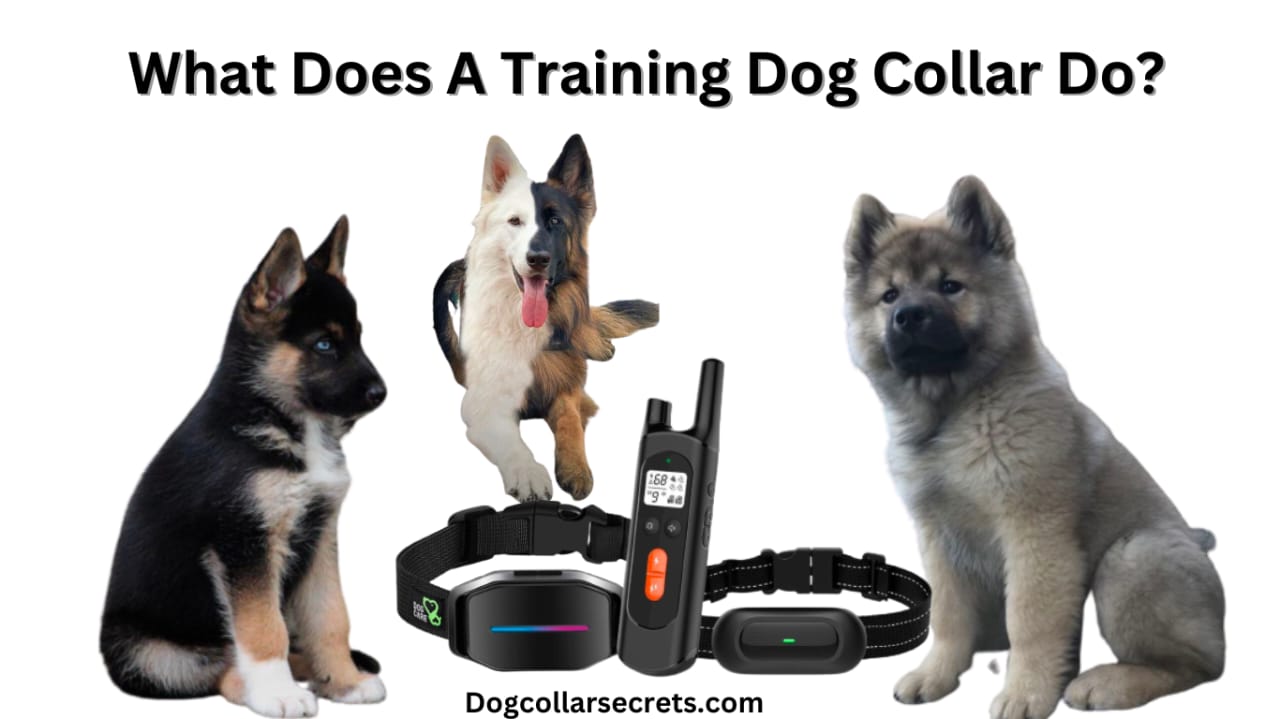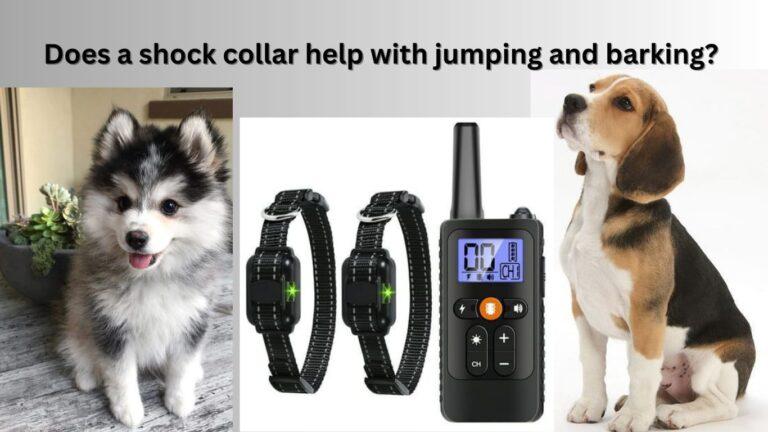Dog Training Collars: What does a training dog collar do?

What does a training dog collar do?
Training dog collars are specialized tools designed to assist pet owners and trainers in teaching dogs good behavior and obedience. These collars serve a distinct purpose in canine training and can be an effective means of communication between humans and their furry companions. The primary aim of training dog collars is to help dogs understand what is expected of them, ensuring their safety and promoting a harmonious relationship with their owners.
Now, addressing your question, “What does a training dog collar do?” – A training dog collar serves to assist in dog training by providing feedback and guidance to the dog. It helps convey signals or corrections to reinforce desired behaviors or discourage unwanted ones, ultimately promoting obedience and safety. When used responsibly and in conjunction with positive reinforcement methods, training collars can be valuable tools in teaching dogs proper behavior and ensuring a harmonious relationship between dogs and their owners.
What Does a Training Dog Collar Do? Exploring Its Role and Purpose
Training collars play a crucial role in dog training for several reasons. Firstly, they provide a means to establish boundaries and reinforce commands, enhancing the safety of both the dog and those around them. For instance, a leash attached to a training collar can prevent a dog from running into traffic or engaging in aggressive behavior.
Secondly, training collars enable consistent and effective communication between the owner and the dog. They allow for immediate feedback, helping the dog understand which actions are acceptable and which are not. This clarity is especially important when teaching complex commands or addressing behavioral issues.
Types of Training Dog Collars
1. Martingale Collars
Martingale collars are a humane alternative to choke chains and are designed to prevent dogs from slipping out of their collars. They consist of two loops – one that goes around the dog’s neck and another that tightens when the dog pulls on the leash, providing gentle correction.
2. Choke Chains
Choke chains are traditional collars made of metal links. When the leash is pulled, they tighten around the dog’s neck, applying pressure. These should be used with caution and proper training to avoid injury.
3. Prong Collars
Prong collars have metal prongs that press into the dog’s neck when tension is applied to the leash. They are controversial and should be used under the guidance of a professional trainer.
4. Electronic Collars (E-collars)
E-collars deliver electrical stimulation to the dog’s neck, allowing remote training. They should only be used by experienced trainers and with proper settings to ensure safety and effectiveness.
5. Head Collars
Head collars, like the Gentle Leader or Halti, fit around the dog’s snout and neck, providing control by redirecting the dog’s head when it pulls. They are gentle and useful for dogs that tend to pull on leashes.
6. No-Pull Harnesses (Collar Alternatives)
No-pull harnesses are an alternative to collars and work by discouraging dogs from pulling. They distribute pressure more evenly and are considered a safer option for training.
How do dog training collars work?
1. Mechanics of Collar Correction
Training collars work by applying pressure or discomfort when the dog exhibits undesirable behavior. For example, choke chains and prong collars tighten, while E-collars deliver stimulation. This prompts the dog to associate the behavior with discomfort, encouraging them to stop.
2. Positive vs. Negative Reinforcement
Positive reinforcement involves rewarding desired behaviors with treats or praise, while negative reinforcement focuses on removing unpleasant stimuli (like collar pressure) when the desired behavior occurs. Effective training often combines both methods, emphasizing positive reinforcement for lasting results.
How do I choose a dog training collar?
1. Considerations for Different Breeds
Different dog breeds have varying temperaments and sensitivities. It’s crucial to select a collar that matches your dog’s size, breed, and individual personality.
2. Training Goals and Methods
Your training goals and methods play a significant role in collar selection. For basic obedience, a martingale or no-pull harness may suffice, while more intense training might require an E-collar or prong collar.
3. Safety and Ethical Concerns
Prioritize your dog’s safety and well-being. Ensure the collar is fitted correctly to prevent injury, and always follow ethical training practices to avoid causing harm or fear.
Considerations for Different Breeds
Different dog breeds exhibit unique characteristics and temperaments, which should be taken into account when selecting a training collar. For example, some breeds are more sensitive and may respond better to gentle collars like martingales or head collars, while others may require more robust correction methods. The breed’s size and physical attributes also play a role in collar selection, ensuring a comfortable and safe fit.
Best dog training collars goals and methods of training
Your training goals and methods are critical factors in determining the most suitable training collar. If you’re working on basic obedience, a no-pull harness or a standard collar may suffice. However, if you’re dealing with specific behavioral issues like excessive pulling or aggression, you may need a collar with more correction capability, such as a prong collar or E-collar. Align your collar choice with your training objectives.
Safety and Ethical Concerns in dog training
Safety and ethics should always be paramount in dog training. When using training collars, ensure they are properly fitted to prevent injury or discomfort. Follow ethical training practices that prioritize positive reinforcement and avoid causing fear or harm to your dog. Training should be a positive and trust-building experience for your furry friend.
Dog Training Techniques with Collars
Training collars are most effective when used in conjunction with appropriate techniques.
- Basic Obedience Training: Utilize positive reinforcement techniques like treats and praise to reward your dog’s desired behaviors when using training collars.
- Behavior Modification: Identify the specific behavior you want to change and use the collar as a tool to discourage unwanted actions while reinforcing positive ones.
- Leash Training: Collars, especially no-pull harnesses, can help with leash training by discouraging pulling and encouraging loose leash walking.
Common Mistakes and Misuses
Mistakes in collar use can have adverse effects on your dog’s training and well-being. Avoid using excessive force or punishment with training collars, as this can lead to fear and aggression. Recognize signs of discomfort or distress in your dog, such as excessive panting, whining, or resistance. If you notice these signs, reassess your training methods and consider alternative approaches.
Avoiding Harmful Practices
Harmful practices, such as using training collars improperly or resorting to harsh corrections, can harm your dog physically and emotionally. Always prioritize positive reinforcement, and avoid choking, jerking, or yanking the leash. Seek guidance from professional trainers if needed to ensure your training methods are safe and effective.
Recognizing Signs of Discomfort
Your dog may exhibit signs of discomfort or distress when using a training collar. These signs can include trying to remove the collar, scratching, or avoiding walks. Pay close attention to your dog’s body language and behaviors, and if you notice any signs of discomfort, consult a professional trainer to adjust your training approach or collar choice accordingly.
Training Collars vs. Positive Reinforcement
It’s essential to understand the pros and cons of different training approaches. Training collars provide immediate correction but can be intimidating for some dogs. Positive reinforcement focuses on rewarding desired behaviors, creating a positive association with training. A balanced approach that combines both methods can be highly effective in achieving your training goals.
Training Collar Accessories
Collars often come with additional features and accessories that enhance their functionality and safety.
- Tags, Identification, and Safety Features: Ensure your dog’s collar includes identification tags with your contact information, promoting their safe return if they get lost. Some collars also feature safety features like reflective materials for nighttime visibility.
- Collar Materials and Durability: Choose collars made from durable materials that can withstand your dog’s activities and play. Nylon, leather, and durable webbing are common choices.
Training Collar Maintenance
Proper maintenance ensures your dog’s collar remains safe and effective.
- Cleaning and Care Tips: Regularly clean your dog’s collar to remove dirt and grime. Follow the manufacturer’s care instructions to maintain its condition.
- Replacement Recommendations: Collars can wear out over time, especially if your dog is active. Replace worn or damaged collars promptly to ensure they continue to function correctly and safely.
Alternatives to Training Collars
Training collars are just one approach to dog training. Consider alternative methods:
- Positive Reinforcement Training: Emphasize rewards and positive associations to shape your dog’s behavior.
- Clicker Training: Use a clicker to signal desired behavior, followed by rewards.
- Professional Dog Training Services: Enlist the help of a professional dog trainer who can tailor a training plan to your dog’s needs.
How do you use a dog training collar effectively?
Using a dog training collar effectively involves understanding the collar type you’re using and employing positive reinforcement techniques. First, choose an appropriate collar based on your dog’s size and training needs. There are various types, including flat collars, martingale collars, choke chains, prong collars, and electronic collars. Ensure it fits snugly but not too tight, allowing you to fit two fingers between the collar and your dog’s neck.
Next, start with positive reinforcement training. This means rewarding your dog for desired behaviors. Whenever your dog behaves well, like following commands or walking calmly on a leash, offer treats, praise, or affection. Use the collar as a gentle tool to guide your dog’s attention and actions, rather than as a punishment. When using an electronic collar, follow manufacturer instructions carefully and always choose the lowest, most humane setting. Never use it to hurt or scare your dog.
The key to effective dog training with a collar is patience, consistency, and positive reinforcement. Choose the right collar, fit it properly, and focus on rewarding good behavior rather than punishing. This approach will help you build a strong, loving bond with your furry friend while teaching them the behaviors you desire.
Conclusion
In conclusion, training dog collars are valuable tools when used responsibly and ethically. They can aid in teaching obedience, improving behavior, and enhancing the bond between you and your canine companion. By understanding the types of collars available and their proper usage, you can embark on a training journey that fosters a happy and well-behaved furry friend.
You can also read this: Can You Leave A Bark Collar On All Night?




